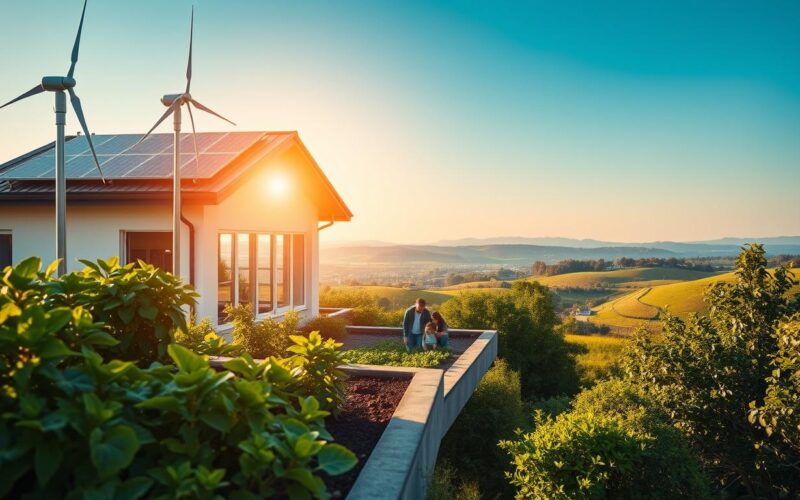Did you know that Americans throw away more than 100 billion plastic bags each year? This staggering fact highlights the urgent need for change in our daily habits. Sustainability is more than just a buzzword; it’s a vital concept for ensuring a healthier planet for future generations. By adopting eco-friendly practices, we can make a significant impact on the environment and our communities.
The idea of sustainable development, as outlined in the Brundtland Report, focuses on meeting today’s needs without compromising the ability of future generations to meet theirs. This approach combines environmental, economic, and social factors to create a balanced framework for global progress. From reducing waste to conserving energy, small changes in our lifestyle can lead to big results.
For example, switching to LED bulbs can save up to 75% of energy compared to traditional incandescent bulbs1. Similarly, washing clothes in cold water can cut energy usage by up to 90%1. These simple adjustments not only benefit the environment but also save money in the long run. Let’s explore practical tips to embrace sustainability and create a greener future.
Key Takeaways
- Sustainability ensures we meet current needs without harming future generations.
- Small changes, like using LED bulbs, can save energy and reduce costs.
- The Brundtland Report highlights the importance of sustainable development.
- Eco-friendly practices benefit both the environment and your wallet.
- Adopting sustainability is essential for a healthier planet.
Introduction to Sustainable Living
The way we use resources today shapes the world of tomorrow. Sustainable living is about making choices that balance our needs with the Earth’s limits. It’s a holistic approach that considers environmental, economic, and social factors to ensure a healthier future.
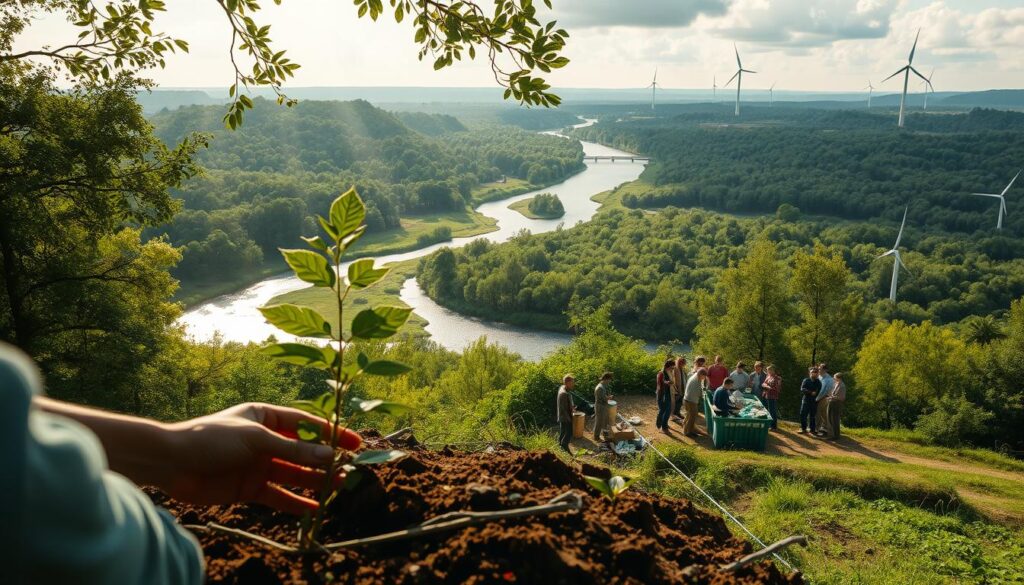
Defining Sustainability in Today’s World
Sustainable living involves preserving natural resources like water, air, and soil. These resources are essential for life, yet they are often overused or polluted. By adopting practices that reduce waste and conserve energy, we can protect these vital assets for future generations2.
Environmental sustainability focuses on reducing pollution and conserving resources. For example, using renewable energy sources like solar or wind power can significantly lower greenhouse gas emissions3. Similarly, reducing water waste helps ensure that everyone has access to clean water, especially as global shortages are expected to rise3.
The Importance of an Eco-Friendly Life
Development that supports ongoing access to essential resources is crucial. The UN’s 17 Sustainable Development Goals highlight the need for global collaboration to address challenges like clean water, climate action, and responsible consumption3.
Responsible resource management is key to securing a healthier future. By making small changes, like shopping locally or reducing food waste, we can collectively make a big impact4. These efforts not only benefit the environment but also improve our quality of life.
Understanding the Pillars of Sustainability
The foundation of a greener future lies in balancing three essential elements. These pillars—environmental, social, and economic—form the backbone of sustainable development. Together, they create a framework that ensures long-term success for both businesses and communities5.

Environmental Sustainability
Environmental sustainability focuses on protecting natural resources and reducing pollution. Companies are increasingly adopting practices like using renewable energy and reducing waste to minimize their ecological footprint6. For example, switching to solar or wind power can significantly lower greenhouse gas emissions6.
Businesses that implement energy-efficient systems often see reduced operational costs. This not only benefits the environment but also improves their bottom line5.
Social Sustainability
Social sustainability emphasizes fairness and equity. It ensures that economic progress benefits all members of society, not just a select few5. Companies like Tony’s Chocolonely and Fairphone are leading the way by promoting fair wages and ethical practices in their supply chains5.
Encouraging remote work and fostering inclusive growth are also key practices. These efforts contribute to employee well-being and community development6.
Economic Sustainability
Economic sustainability involves creating long-term value while maintaining financial stability. Businesses are adopting circular economy models, like MUD Jeans, to reduce waste and promote sustainable consumption5.
Proactive compliance with environmental regulations, such as carbon accounting, helps companies identify areas for improvement. This drives innovation and enhances their corporate reputation5.
| Pillar | Key Practices | Examples |
|---|---|---|
| Environmental | Renewable energy, waste reduction | Solar power, recycling initiatives |
| Social | Fair wages, inclusive growth | Fairphone, Tony’s Chocolonely |
| Economic | Circular economy, carbon accounting | MUD Jeans, ISO 50001 certification |
The Evolution of Sustainability Concepts
From ancient forestry practices to modern climate policies, sustainability has evolved significantly. The concept of preserving resources dates back centuries, shaping today’s environmental efforts. This journey reflects humanity’s growing awareness of the need to protect the planet and address pressing climate challenges.
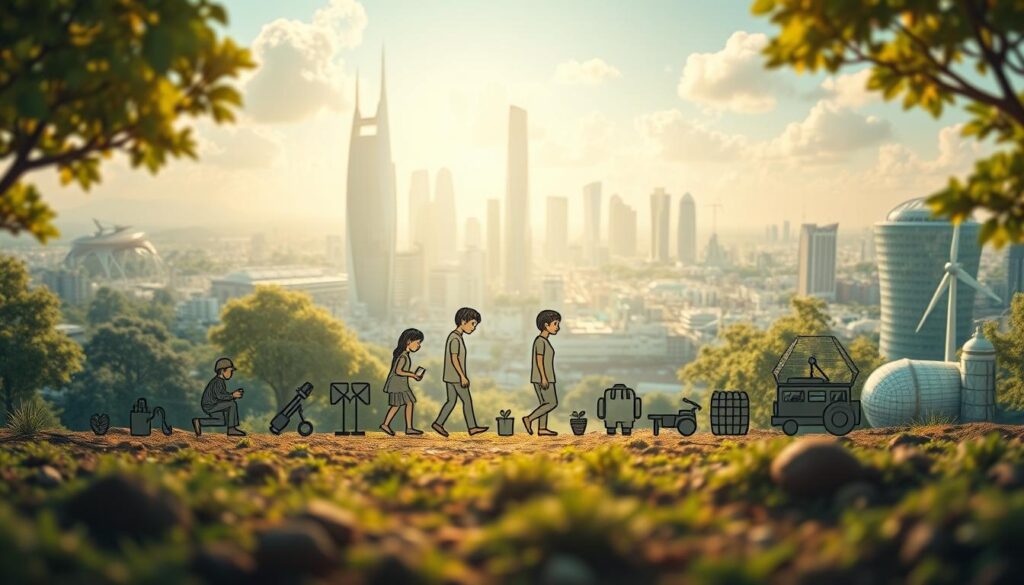
Historical Perspectives from Past to Present
The roots of sustainability can be traced to Hans Carl von Carlowitz, who introduced sustainable forestry in the 18th century. His ideas emphasized managing resources to meet long-term needs without depleting them7. In the U.S., the conservation movement gained momentum in the 19th century with the establishment of Yellowstone National Park in 18727.
By the 20th century, global initiatives like the 1972 United Nations Conference on the Human Environment marked a shift toward broader environmental concerns7. The 1987 Brundtland Report further defined sustainable development, emphasizing the balance between economic growth and environmental protection7.
Modern Challenges and Opportunities
Today, society faces unprecedented challenges, including rising global temperatures and resource scarcity. As of 2020, the U.S. generated 292.4 million tons of waste, with only 32.1% being recycled or composted7. These issues highlight the urgent need for innovative solutions.
Modern opportunities include advancements in renewable energy and policy reforms. Companies like IBM and Panasonic are leading the way with commitments to achieve net-zero emissions by 2030 and 2050, respectively8. These efforts demonstrate the potential for businesses to drive positive change.
“The future will be green, or not at all.”
| Era | Key Milestones | Impact |
|---|---|---|
| 18th Century | Sustainable forestry practices | Resource management principles |
| 19th Century | U.S. conservation movement | Preservation of natural areas |
| 20th Century | Global environmental initiatives | Shift toward sustainable development |
| 21st Century | Corporate sustainability commitments | Innovation and policy reforms |
Key Sustainable Practices for Daily Life
Every small action we take today shapes the world of tomorrow. Adopting eco-friendly habits can make a significant difference in preserving resources and reducing waste. From conserving water to minimizing energy use, these practices are easy to integrate into daily routines.
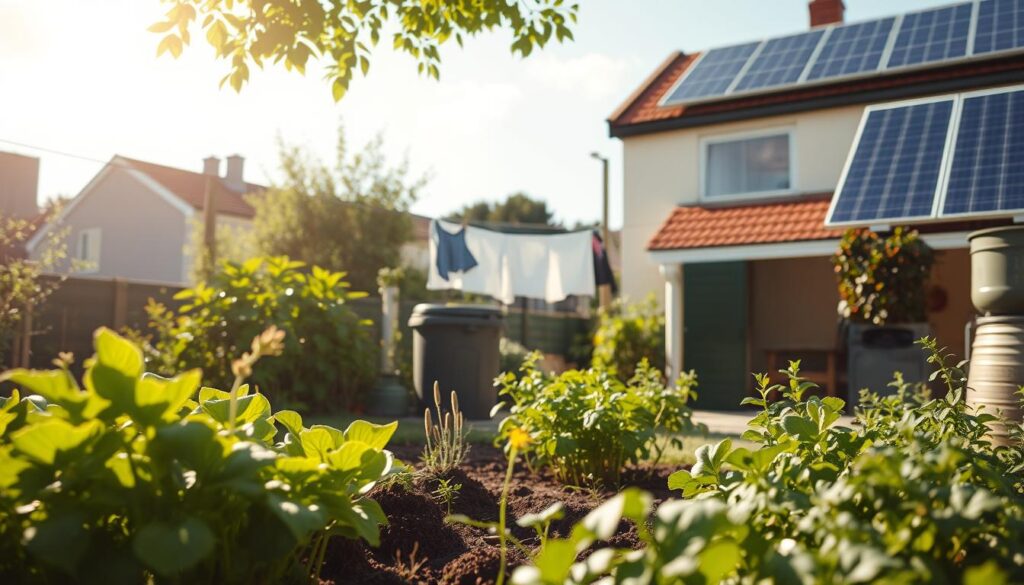
Simple Lifestyle Changes for Eco-Friendliness
Switching to energy-saving light bulbs can reduce carbon emissions by up to 40kg annually9. These bulbs also last up to 12 times longer than traditional ones, saving money and resources. Another simple change is using smart thermostats, which can cut energy use by 16.5%9.
Reducing single-use plastics is another effective step. For example, carrying reusable bags and bottles can significantly cut down on waste. Over a year, these small changes can add up to substantial environmental benefits.
Practical Tips to Reduce Waste and Conserve Resources
Conserving water is crucial. Fixing leaks and installing low-flow fixtures can save thousands of gallons annually. Additionally, washing clothes in cold water reduces energy use by up to 90%10.
Food waste is another area to address. Planning meals and storing food properly can prevent unnecessary waste. In 2018, the UK generated 9.5 million tonnes of food waste, equivalent to 25 million tonnes of greenhouse gas emissions9.
| Practice | Benefit | Example |
|---|---|---|
| Energy-saving bulbs | Reduces carbon emissions | 40kg saved annually9 |
| Smart thermostats | Cuts energy use | 16.5% reduction9 |
| Reusable items | Reduces plastic waste | Bags, bottles |
| Water conservation | Saves water | Low-flow fixtures |
| Food waste reduction | Lowers emissions | Meal planning |
Embracing Renewable Energy and Resource Management
The shift to renewable energy is reshaping how we power our lives and businesses. Organizations worldwide are adopting solar, wind, and hydropower to reduce their environmental footprint. This transition not only lowers greenhouse gas emissions but also creates new opportunities for innovation and growth11.
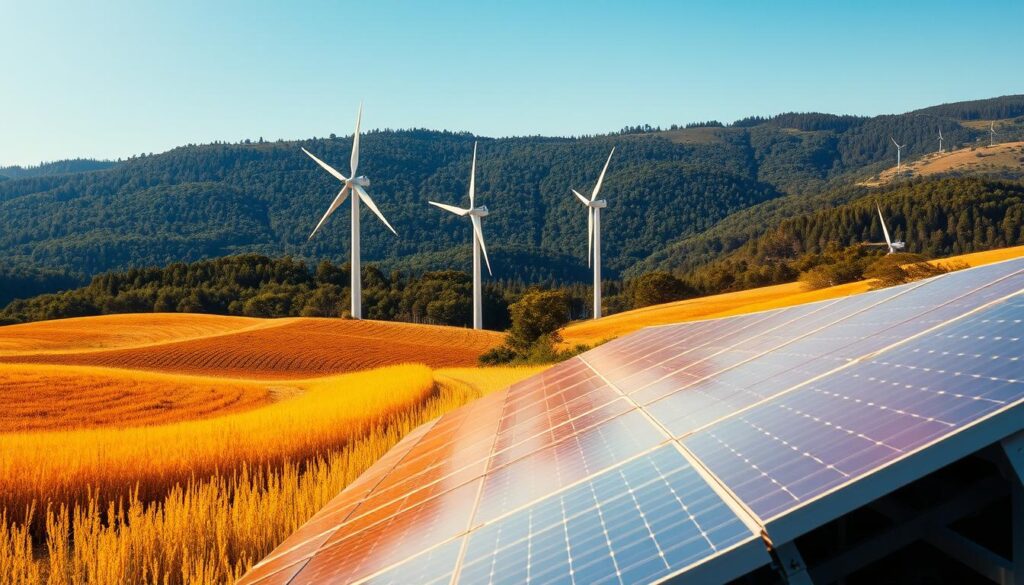
Benefits of Renewable Energy Solutions
Renewable energy sources like solar and wind are transforming the energy landscape. In 2020, they accounted for 19.1% of global energy consumption, with solar and wind leading the charge12. These alternatives are not only cleaner but also more cost-effective in the long run.
Companies like Google and Apple are investing heavily in renewable energy. Google, for instance, has matched 100% of its energy use with renewable sources since 201711. Such initiatives demonstrate how organizations can achieve both environmental and financial benefits.
- Solar Power: Reduces reliance on fossil fuels and lowers energy costs.
- Wind Energy: Provides a scalable solution for large-scale energy needs.
- Hydropower: Offers a reliable and consistent energy source.
Managing Water and Natural Resources Effectively
Water scarcity is a growing concern, making effective management essential. Techniques like drip irrigation and rainwater harvesting are proving to be game-changers11. These methods not only conserve water but also improve agricultural efficiency.
Organizations are also adopting circular economy models to minimize waste. By keeping materials in use longer, they reduce resource depletion and environmental impact11. For example, IKEA has committed to using only renewable or recycled materials by 2030.
Here are some key strategies for resource management:
- Water Conservation: Fix leaks and use low-flow fixtures.
- Waste Reduction: Implement recycling and composting programs.
- Energy Efficiency: Upgrade to ENERGY STAR-certified appliances12.
By integrating these practices into daily life, we can secure a more resilient future. The opportunity to reduce emissions and conserve resources is within reach, and it starts with informed choices.
Integrating Sustainability into Business Strategies
Businesses today are redefining success by integrating eco-conscious strategies into their core operations. This shift is driven by the need to address climate change while maintaining profitability. Companies are now embedding environmental responsibility into their long-term goals, ensuring they remain competitive in a rapidly changing world13.
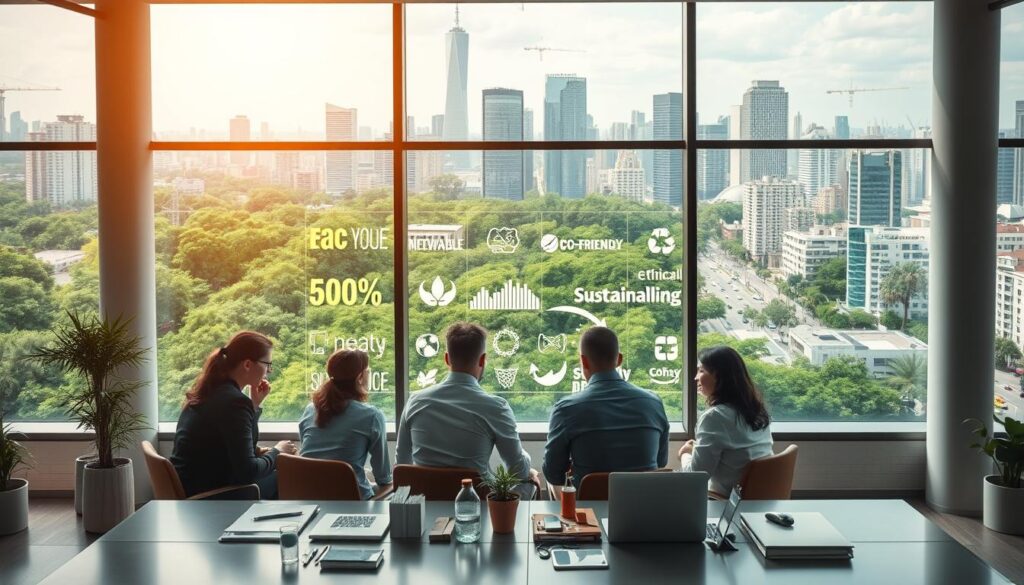
Corporate Sustainability Goals and Approaches
Many organizations are setting ambitious targets to reduce their environmental impact. For example, leading companies are committing to net-zero emissions by 2030 or 2050, aligning with global initiatives like those from the United Nations14. These goals often include transitioning to renewable energy sources, improving energy efficiency, and adopting circular economy models.
Investors are increasingly focusing on companies with strong sustainability practices, recognizing their long-term value and resilience13. This trend is pushing businesses to innovate and find new ways to balance profitability with planetary health. For instance, Google has matched 100% of its energy use with renewable sources since 2017, showcasing its ability to lead by example13.
Identifying and Avoiding Greenwashing Tactics
As companies strive to meet sustainability goals, the risk of greenwashing—making false or exaggerated environmental claims—has grown. To avoid this, businesses must ensure their efforts are genuine and measurable. The United Nations provides guidelines to help companies maintain transparency and accountability14.
Effective strategies include third-party certifications, detailed reporting, and stakeholder engagement. For example, Patagonia’s commitment to ethical sourcing and environmental activism has earned it a reputation for authenticity. This approach not only builds trust but also strengthens the company’s ability to drive real change13.
“Sustainability is no longer just a nice-to-have; it’s a must-have for businesses that want to thrive in the future.”
| Strategy | Key Actions | Examples |
|---|---|---|
| Net-Zero Goals | Transition to renewable energy, improve efficiency | Google, Apple |
| Circular Economy | Reduce waste, reuse materials | IKEA, MUD Jeans |
| Transparency | Third-party certifications, detailed reporting | Patagonia, Fairphone |
By adopting these practices, businesses can address climate change while enhancing their reputation and operational efficiency. The journey toward sustainability requires commitment, innovation, and collaboration, but the rewards are well worth the effort14.
Technology and Innovation Driving Sustainable Change
Innovation is reshaping the future of industries, with technology playing a pivotal role in driving sustainable change. From optimizing energy usage to reducing waste, modern tools like AI and IoT are transforming how companies operate. These advancements not only improve efficiency but also minimize environmental impact, creating a balance between economic growth and ecological preservation.

Utilizing AI, IoT, and Data Analytics
Artificial Intelligence (AI) and the Internet of Things (IoT) are revolutionizing resource management. AI-driven analysis of production data helps companies minimize waste, energy usage, and material consumption15. For example, real-time tracking software interfaces with IoT devices to provide sustainability data, enhancing product freshness and reducing shipping damage15.
Blockchain technology offers complete traceability of a product’s life cycle, enabling companies to measure their environmental impact15. This transparency empowers every person in the organization to contribute to sustainability goals, fostering a culture of accountability.
Digital Transformation and Environmental Impact
Digital transformation is key to achieving efficient resource use. Advanced AI modeling and bioengineering create materials like bio-fabricated leather and carbon-negative cement, reducing reliance on harmful processes15. Additionally, digital twins simulate manufacturing processes to identify inefficiencies, leading to reduced waste and optimized resource use15.
Companies like Microsoft and Google are leading the way. Microsoft has committed to achieving net-zero emissions by 2030, while Google matches its energy use with renewable sources hourly16. These efforts demonstrate how technological advancements can drive both environmental and economic benefits.
“The future of sustainability lies in the seamless integration of technology and innovation.”
By embracing these technologies, companies can reduce their carbon footprint while maintaining profitability. The synergy between innovation and sustainability is paving the way for a greener future.
Global Policies and Sustainable Development Goals
The world is uniting to address pressing environmental challenges. Global policies and frameworks are essential to guide actions and ensure progress. These initiatives provide a roadmap for countries, organizations, and individuals to work together toward a healthier planet.
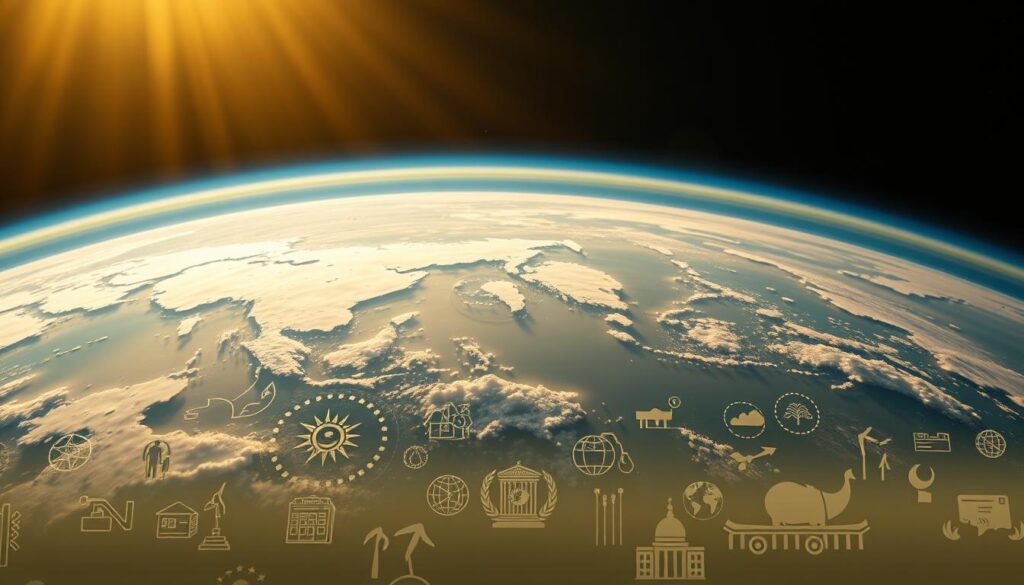
UN Sustainable Development Goals and International Initiatives
In 2015, the UN adopted 17 Sustainable Development Goals (SDGs) as part of the 2030 Agenda. These goals aim to end poverty, protect the planet, and tackle inequalities17. Achieving the SDGs could unlock $12 trillion in market opportunities and create 380 million new jobs by 203018.
However, as of 2023, only 17% of the SDGs are on track. About 30% of evaluated targets have made marginal progress, while 35% show regression or stagnation17. This highlights the urgent need for increased collaboration and investment.
The Joint SDG Fund has committed $268 million across 236 programs, catalyzing nearly $5 billion in additional investments17. Such efforts demonstrate the potential of international cooperation to drive meaningful change.
Government Regulations and Environmental Standards
Governments play a critical role in shaping environmental policies. Regulations and standards ensure compliance and encourage innovation. For example, the UN Statistical Commission monitors progress using 231 indicators, providing a clear framework for accountability17.
Countries like Finland, Sweden, and Denmark lead in SDG progress, while the U.S. ranks 46th17. This disparity underscores the issue of uneven implementation and the need for stronger commitments.
Global initiatives like the SDG Stimulus call for an additional $500 billion in sustainable development financing annually17. Such measures are essential to bridge the $4 trillion gap between current funding and SDG requirements17.
“Global challenges require global solutions. The SDGs provide a shared blueprint for peace and prosperity.”
By aligning policies and fostering international cooperation, we can address critical environmental issues and create a sustainable future for all.
Community and Social Engagement in Sustainability
Communities hold the power to drive meaningful change in protecting our planet. By working together, individuals can reduce emissions, safeguard ecosystems, and create a lasting impact for future generations. Grassroots movements and local initiatives are proving to be effective tools in addressing environmental challenges.

Local Initiatives and Grassroots Movements
Community engagement is essential for fostering sustainable practices. Organizations that actively involve their communities are 2.5 times more likely to report significant improvements in social responsibility metrics19. This collaboration ensures that initiatives are relevant and responsive to local needs, leading to effective and lasting solutions19.
For example, the MyCleanCity initiative in India has mobilized local citizens, students, and businesses to improve waste management practices significantly19. Similarly, the Detroit Blight Removal Task Force engaged community members in mapping blighted areas and participating in clean-up activities, enhancing trust and transparency19.
Reducing emissions can be driven by collective action at the community scale. In Pune, India, over 3,000 waste pickers are employed in a decentralized waste collection model, which ensures efficient waste management and provides stable livelihoods20. Approximately 50% of Pune’s waste is recycled or composted, significantly reducing landfill dependency and methane emissions20.
Protecting local ecosystems is another critical focus. Educational campaigns in Pune promote responsible waste segregation among residents, enhancing public awareness and reducing groundwater contamination20. These efforts demonstrate how community-led projects can create a significant environmental impact while improving quality of life.
“When communities come together, they can achieve extraordinary things for the planet and future generations.”
| Initiative | Impact | Location |
|---|---|---|
| MyCleanCity | Improved waste management | India |
| Detroit Blight Removal | Enhanced community trust | USA |
| Pune Waste Management | Reduced emissions and landfill use | India |
By nurturing conditions that benefit future generations, communities can lead the way in creating a healthier planet. These efforts not only protect ecosystems but also inspire others to take action, amplifying the global impact of sustainability initiatives.
Sustainability: A Comprehensive Approach
Balancing immediate development with long-term environmental preservation is a critical challenge for modern society. This requires a holistic approach that integrates economic growth with strict environmental limits. By focusing on reducing pollution and optimizing resource use, we can create a framework for responsible development.
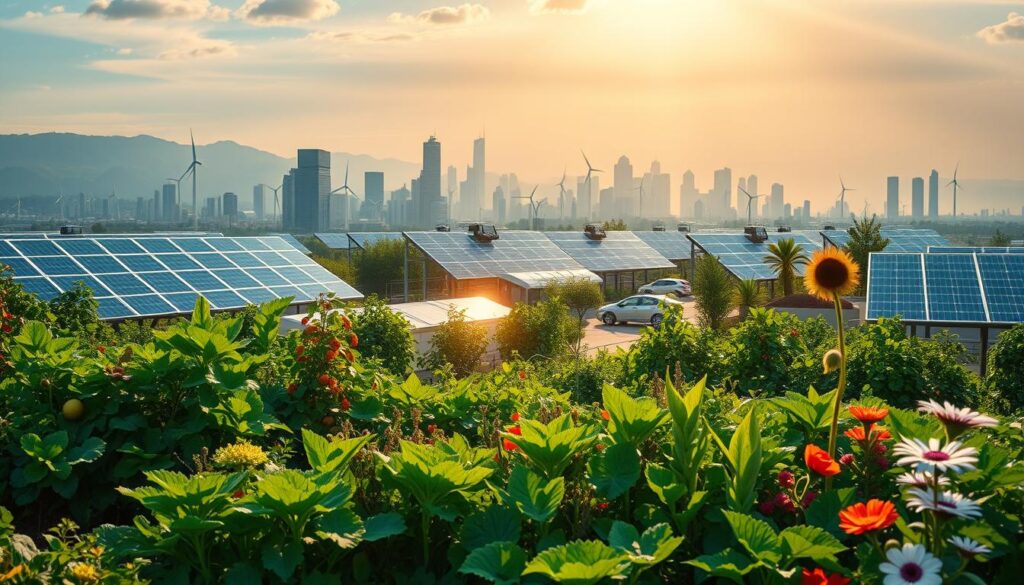
Effective strategies for reducing pollution include adopting renewable energy and implementing waste reduction programs. For example, LEED certification has been a foundational element in sustainable design since 1993, emphasizing energy efficiency and resource conservation21. Similarly, the Global Reporting Initiative (GRI) Standards provide a framework for organizations to measure and report their environmental impact22.
Proper use of resources over a long-term period is essential for maintaining environmental balance. This includes selecting durable materials and incorporating multi-functional designs that extend the lifespan of spaces21. By repurposing and recycling materials, we can minimize waste and reduce the frequency of renovations21.
Real-world activity demonstrates how businesses and governments collaborate to ensure responsible development. For instance, the Carbon Disclosure Project (CDP) manages a global environmental disclosure system for over 23,000 companies, promoting transparency and accountability22. Such initiatives highlight the importance of continuous monitoring and adaptation in achieving a truly comprehensive approach.
“The integration of economic growth and environmental preservation is not just a goal but a necessity for future generations.”
By fostering collaboration and leveraging advanced technologies, we can address environmental challenges while sustaining economic activity. This balanced approach ensures that development meets current needs without compromising the ability of future generations to meet theirs.
Conclusion
Creating a greener future requires collective effort from individuals, businesses, and governments. Government policies play a crucial role in setting standards and encouraging eco-friendly practices. For example, initiatives like the UN Sustainable Development Goals provide a roadmap for global progress23.
Experts emphasize the importance of innovation in overcoming environmental challenges. Advancements in technology, such as AI and renewable energy, are transforming industries and reducing emissions24. These tools help optimize resource use and minimize waste, making sustainability more achievable.
Every generation has a part to play in addressing these challenges. From reducing plastic waste to conserving water, small actions add up to significant impact. For instance, replacing halogen bulbs with energy-efficient alternatives can cut energy use by six times24.
Let’s commit to integrating these practices into our daily lives and supporting broader initiatives. Together, we can build a healthier planet for future generations.
FAQ
What is the definition of sustainability in today’s world?
Why is an eco-friendly lifestyle important?
What are the three pillars of sustainability?
How has the concept of sustainability evolved over time?
What are some simple ways to live more sustainably?
How can businesses integrate sustainability into their strategies?
What role does technology play in driving sustainable change?
What are the UN Sustainable Development Goals (SDGs)?
How can communities contribute to sustainability efforts?
How can we balance development needs with environmental limits?
Source Links
- 101 climate solutions you can do at home – https://www.oneearth.org/101-climate-solutions-you-can-do-at-home/
- What Is Sustainability? (And Why Is It Important?) – https://www.coursera.org/articles/what-is-sustainability
- What is Environmental Sustainability? Goals With Examples – https://www.snhu.edu/about-us/newsroom/stem/what-is-environmental-sustainability
- What is Sustainable Living? – https://www.sustainablejungle.com/what-is-sustainable-living/
- The three pillars of sustainability: people, planet, and profit – https://www.coolset.com/academy/three-pillars-of-sustainability
- What are the Three Pillars of Sustainable Development? – https://greenly.earth/en-gb/blog/company-guide/3-pillars-of-sustainable-development
- The Evolution of Sustainability: Key Insights and Future Directions – Emerald Ecovations – https://emeraldecovations.com/2024/05/evolution-of-sustainability/
- Evolution of Sustainability Practices: Complete Overview – https://hummingbirdinternational.net/evolution-of-sustainability-in-business/
- 40 Ways to Be More Eco Friendly in 2025 | GreenMatch – https://www.greenmatch.co.uk/blog/how-to-be-more-eco-friendly
- How to achieve environmental sustainability – https://greenly.earth/en-us/blog/company-guide/how-to-achieve-environmental-sustainability
- What is Sustainable Resource Management? – – https://missionsustainability.org/blog/sustainable-resource-management/
- The Future of Renewable Energy Management and Strategies – https://entrapeer.com/market-research/the-future-of-renewable-energy-management-and-strategies/
- From Concept to Core: Integrating Sustainability into Business Strategy – https://www.notogroup.com/post/integrating-sustainability-into-business-strategy
- 4 ways to integrate sustainability and corporate strategy – https://www.earthfinance.com/insights/4-ways-to-integrate-sustainability-and-corporate-strategy
- 15 Ways Technology Is Driving Sustainable Manufacturing – https://www.forbes.com/councils/forbestechcouncil/2025/02/11/16-ways-technology-is-driving-sustainable-manufacturing/
- Sustainable technology and its role in sustainable development – https://instituteofsustainabilitystudies.com/insights/guides/the-role-of-technology-in-sustainable-development/
- What Are the UN Sustainable Development Goals? – https://www.cfr.org/backgrounder/what-are-un-sustainable-development-goals
- The Sustainable Development Agenda – United Nations Sustainable Development – https://www.un.org/sustainabledevelopment/development-agenda/
- Empowering Social Responsibility Through Community Engagement – https://www.jointhecollective.com/article/empowering-social-responsibility-through-community-engagement/
- Community Engagement for Sustainability: A Blueprint for Inclusive Development – https://thecsruniverse.com/articles/community-engagement-for-sustainability-a-blueprint-for-inclusive-development
- American Society of Interior Designers | ASID – https://www.asid.org/news/sustainability-beyond-materials-the-holistic-approach-to-eco-friendly-design
- Top Sustainability Frameworks: A Comprehensive Comparison – https://esgthereport.com/the-top-sustainability-frameworks-for-organizations/
- The Role of Consumers in Driving Sustainability Outcomes – https://www.clarasight.com/articles/the-role-of-consumers-in-driving-sustainability-outcomes
- The importance of environmental sustainability for future generations • Greengage Solutions – https://www.greengage.solutions/environmental-sustainability-for-future-generations/
